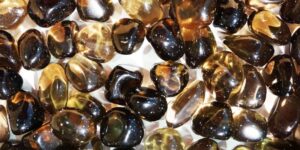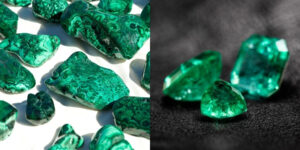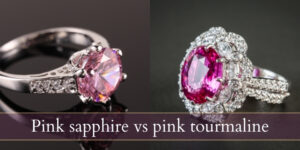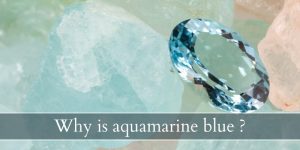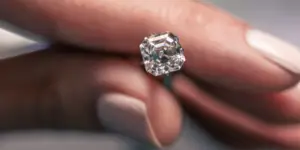Gemstones come in many different shapes, sizes, and colors. In order to make each and every stone shine and catch attention, different cuts are used. Most of the cuts you’re already aware of, since they’re the ones you see in most jewelry, such a cushion cut, pear cut, brilliant cut, and so on. Those are faceted cuts, which bring light into the gemstone so it can shine from within.
And then there are cabochons, and they look vastly different. You may already know cabochons without knowing their name. Today we’re going to take a look at what this type of gemstone cutting is, how it’s best used, and what gems are usually cut this way.
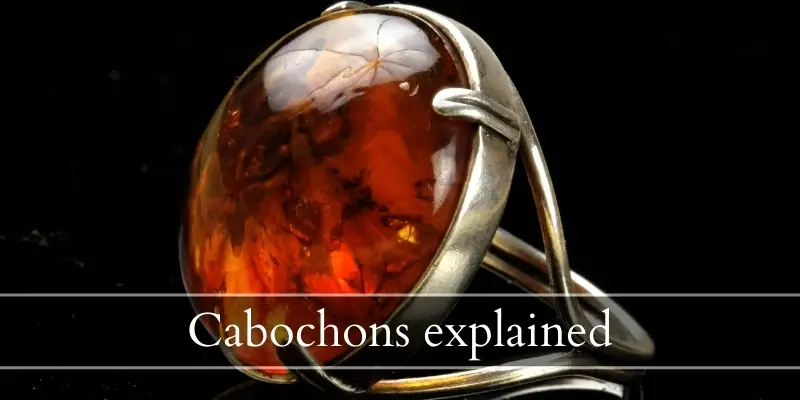
What is a cabochon ?
A cabochon is a type of gemstone cut, with a (usually flat back and a polished, domed top. It has no angular cuts or facets, instead it’s a rounded and polished-looking stone. This type of cut is used for softer stones and in some very special gemstone that feature asterism.
Cabochons are a very old, ancient form of stone cutting. Precise tools were not available in the beginning of mankind, yet gemstones were still beautiful. So a way to polish the stones and set them into jewelry was needed, and thus the cabochon was invented.
What stones are cut into cabochons ?
Not all stones can be cut into cabochons, or rather some gemstones look much better as faceted stones. Cabochons are usually reserved for soft stones. A stone is soft if it ranks a 7 or lower on the Mohs hardness scale. Here’s an example of the most common gemstones, and their hardness scale:
- diamond – 10 on Mohs scale
- sapphire and ruby (same family, corundum) – 9.0 on Mohs scale
- moissanite – 9.25 on Mohs scale
- opal – 5.5-6 on Mohs scale
- agate – 6.5-7 on Mohs scale
- moonstone – 6.0 on Mohs scale
- emerald – 7.5-8 on Mohs scale
- topaz – 8.0 on Mohs scale
- peridot – 6.5-7 on Mohs scale
- amethyst – 7.0 on Mohs scale
- quartz – 7 on Mohs scale
What the Mohs scale measures is a stone’s ability to withstand cracking, scratching, and fissuring. Diamonds rank the highest because they are the toughest gemstone, and this scale applies to minerals and metals as well.
Read also: Gem Settings Explained
So softer stones will scratch and break easier than harder stones. This means cutting these stones into cabochons is easier and safer for them, so that is how they end up. You will rarely see a cabochon that is also transparent. In general the stones that are able to become transparent are also harder, or at least hard enough to cut into a facet cut.
Milky and opaque stones are usually softer, because they end up with more impurities within, which make them more unstable.
Can you cabochon a diamond ?
Yes, you can cut a diamond into a cabochon but you would waste its potential. A diamond relies heavily on a faceted cut to shine, as the light enters the gemstone and is refracted through the many facets. Cutting a diamond into a cabochon is possible, but pointless.
If you’re looking for a white/clear cabochon, look for quartz or white amethyst. Or, you may also look for moonstone and white opal if you’re looking for a whitish stone that is not a facet cut.
Are cabochons valuable ?
Cabochons are generally less valuable than faceted cuts, because they are simpler cut and because they are usually applied to less valuable gemstones. Soft stone cabochons are always going to be less valuable than a facet cut stone.
Some cabochons are exceptions to this, because they are made of a different gemstone.
Cabochon gemstones with asterism are very valuable
The most expensive cabochons are the ones where the stone exhibits an asterism. That is when the stone has tubular inclusions that have arranged themselves in the shape of a star. The number of points varies from start to star, though the most common are 6-pointed stars.
Those stones are always cut as cabochons, and they may have a higher dome to fully display the asterism. These are very expensive gemstones, and on top of this they may even be very precious stones like sapphire, ruby, emeralds.
What holds a cabochon ?
Because of the shape of a cabochon, it need a setting that if very tight and fits snugly all around the stone. There are two main ways of holding a cabochon in place, and they offer very different effects, which we’ll explain below.
A bezel setting
Bezel setting is the most common and protecting way of holding a cabochon, or setting it into jewelry. Since cabochons are fairly large, this is also the best way to make sure they don’t somehow wiggle out of the setting.
A bezel setting is a strip of metal that goes all around the outside of the cabochon, and it closes a bit over the sides of the cabochon. Since cabochons have their base cut at a slight angle, the bezel wrapping over that cut ensure the stone will not slide out.
This type of stone setting is safe, protects the stone from most shocks, and ensure it won’t easily break or crack.
Prong setting
Prong setting is not very common in cabochon stones, though it can be safely used if there is an outer guard and the stone is not very large. If a prong setting is used, the prongs are usually a bit longer than for faceted stones.
Wrap wire
Some cabochons – usually earrings and pendants – are wrapped with wire. This gives them a more rugged, antique look and is most common in hand-crafted stores. Depending on your tastes a wire setting may look better or not. Wire wrapping allows forming some beautiful, intricate designs.

I’m the main author for jewelrymaterialguide.com. I started this site after we did tons of research before our wedding and noticed that there is information about rings, jewelry, and so on that is really hard to find on the internet.

